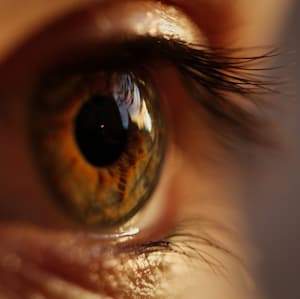Phase 3 MOJAVE Trial Reports Efficacy of NOV03 for Dry Eye Disease
The second pivotal Phase 3 trial reported NOV03 consistently met primary endpoints for signs and symptoms of DED associated with meibomian gland dysfunction.
Credit: Marc Schulte/Pexels

New data from the phase 3 MOJAVE trial indicate NOV03 (perfluorohexyloctane) consistently met primary endpoints for the signs and symptoms of dry eye disease (DED) associated with meibomian gland dysfunction (MGD).1
The trial findings followed positive results from the first pivotal phase 3 trial, GOBI, announced by Bausch + Lomb and Novaliq in early 2023.2 An investigational ophthalmic drop, NOV03 has been assigned a Prescription Drug User Fee Act (PDUFA) action date of June 28, 2023 by the US Food and Drug Administration (FDA).
“In addition to meeting both primary sign and symptom efficacy endpoints, NOV03 was shown to be very well tolerated in the MOJAVE study,” said Yehia Hashad, MD, executive vice president, Research & Development, and chief medical officer, Bausch + Lomb.3 “These are all critical factors that must be considered when determining a treatment plan for someone with a chronic and progressive condition like DED associated with MGD. Excess tear evaporation is a major factor in DED associated with MGD, which remains largely unaddressed.”
Millions of Americans are affected by DED and it is considered one of the most common ocular surface disorders. NOV03 is an investigational, proprietary, water-free, single-component, preservative-free, ophthalmic drop indicated for DED associated with MGD. Results from the GOBI trial suggests NOV03 dosed 4 times daily demonstrated significant reductions in the signs and symptoms of DED compared to hypotonic saline (0.6%).4
Similarly designed to GOBI, the phase 3 MOJAVE trial was conducted at 42 sites in the US between November 2020 and August 2021. Eligible patients were randomized via an interactive system in a 1:1 ratio to receive either NOV03 or hypotonic saline solution (0.6%). Patients were instructed in the study to instill 1 drop of into each eye 4 times daily for 8 weeks.
The full analysis population consisted of 620 subjects aged 18 years and older: 311 in the NOV03 group and 309 in the control group. The two primary endpoints were considered the change from baseline at Week 8 (Day 57 ± 2 days) in total corneal fluorescein staining (tCFS) and eye dryness Visual Analog Scale (VAS) score. The key secondary endpoints included the change from baseline in eye dryness VAS score and tCFS at week Week 2 (Day 15 ± 1), as well as eye burning/stinging VAS score, and central corneal fluorescein at week 8.
Those treated with NOV03 experienced significantly greater reduction from baseline at Week 8 in both tCFS score and VAS dryness score versus patients in the control saline group (least-squares mean treatment difference, -1.2; 95% confidence interval [CI], -1.7 to -0.8; P <.001). The least-squares mean treatment difference for change from baseline to Week 8 in VAS dryness score was –10.2 (95% CI, –14.4 to –6.1; P <.001).
For all key secondary endpoints, MOJAVE investigators found the mean improvement from baseline was significantly greater for NOV03 versus saline control. At Week 2, data showed tCFS and VAS dryness scores were statistically significant compared to saline, with a least-squares mean treatment difference for changing from baseline in tCFS of -0.6 (95% CI, -1.0 to -0.2; P = .001) and VAS score of -7.8 (95% CI, -11.3 to -4.3; P <.001). Additionally, at week 8, VAS burning/stinging score and cCFS favored the NOV03 group, with a least-squares mean treatment difference for change from baseline of -7.3 (95% CI, -11.3 to -3.4; P <.001) and -0.3 (95% CI, -0.5 to -0.2; P <.001), respectively.
The therapy was well-tolerated in MOJAVE and ocular adverse events were experienced by 12.9% of patients in the NOV03 group and 12.3% of patients in the saline group, with most mild or moderate in severity. Ocular adverse events were considered related to treatment in 6.4% of the NOV03 group and 6.8% in the saline group, but none led to treatment discontinuation or study withdrawal. The most common events (incidence ≥1%) reported in the NOV03 group were blepharitis, conjunctival hyperemia, conjunctival papillae, ocular hyperemia, blurred vision, hordeolum, and visual acuity reduction.
“Currently there are no FDA-approved prescription therapies available which directly target evaporation, leaving patients with limited treatment options,” said Christina Ackermann, president, Ophthalmic Pharmaceuticals, Bausch + Lomb.3 “These data are consistent with the results seen in the first Phase 3 trial, and further support NOV03 as a new potential therapy designed to alleviate the signs and symptoms of DED associated with MGD.”
References
- Sheppard JD, Kurata F, Epitropoulos AT, Krösser S, Vittitow JL; MOJAVE STUDY GROUP. NOV03 for Signs and Symptoms of Dry Eye Disease Associated With Meibomian Gland Dysfunction: the Randomized Phase 3 MOJAVE Study: NOV03 for Dry Eye Disease Associated With Meibomian Gland Dysfunction (69 characters; limit, 60) [published online ahead of print, 2023 Mar 20]. Am J Ophthalmol. 2023;S0002-9394(23)00098-3. doi:10.1016/j.ajo.2023.03.008
- Bausch + Lomb and Novaliq Announce Publication of Pivotal Phase 3 Data on NOV03 (Perfluorohexyloctane) in Ophthalmology. Bausch + Lomb News Releases. (2023, January 4). Retrieved March 24, 2023, from https://www.bausch.com/news/releases/?id=131
- Bausch + Lomb and Novaliq Announce Publication of Second Pivotal Phase 3 Data on NOV03 (Perfluorohexyloctane) in American Journal of Ophthalmology. Bausch + Lomb News Releases. (2023, March 22). Retrieved March 24, 2023, from https://www.bausch.com/news/releases/?id=143
- Iapoce, C. (2023, January 5). Nov03 eye drops exhibit improvement in signs, symptoms of dry eye disease. HCP Live. Retrieved March 24, 2023, from https://www.hcplive.com/view/nov03-eye-drops-improvement-signs-symptoms-dry-eye-disease